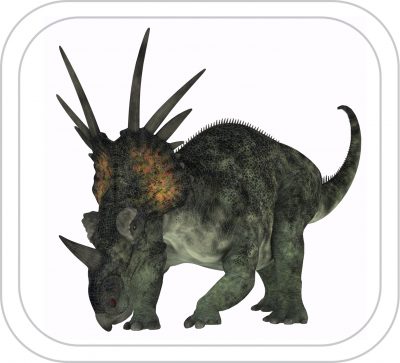Styracosaurus
Name: Styracosaurus
Pronounced: sty-RAK-oh-sore-us
Meaning: ‘Spiked lizard’
Period: Late Cretaceous (76 – 70 million years ago)
Group: Ceratopsians (horn faces)
Size: It was 5.5m long and stood about 1.8 meters tall. It weighed nearly 3000kg.
Diet: Herbivore
Characteristics: The Styracosaurus walked on four short legs and had a short tail but a huge body. The most prominent feature was the four to six long horns extending from its neck frill. It also had a smaller horn on each of its cheeks and a single horn extending from its nose, which is believed to have been up to 15cm wide and 60 cm long. The function of these horns and frills are still a question of debate. The jaw was tipped with deep, narrow beak and contained shearing cheek teeth, which were believed to have been better at plucking and grasping, than they were at biting. This indicates it ate plants. It probably fed on low vegetation as suggested by the position of the head, but they may have been able to knock down trees due to their large weight. Like other ceratopsians, the Styracosaurus is believed to have been a herd animal, travelling in large groups, as many fossils have been found together.
Named by Lawrence Lambe in 1913
Discovery: The first fossil remains of Styracosaurus were collected in Alberta, Canada by Charles Mortram Sternberg from the Dinosaur Park Formation in 1913.

